Quickstart Guide
Last Change: 2025-08-27 #dba #jta
Spherene is a cloud-based Autodesk Fusion Add-In service that requires registration. When you activate Spherene computation for the first time, a request window will appear prompting you to enter your API key.
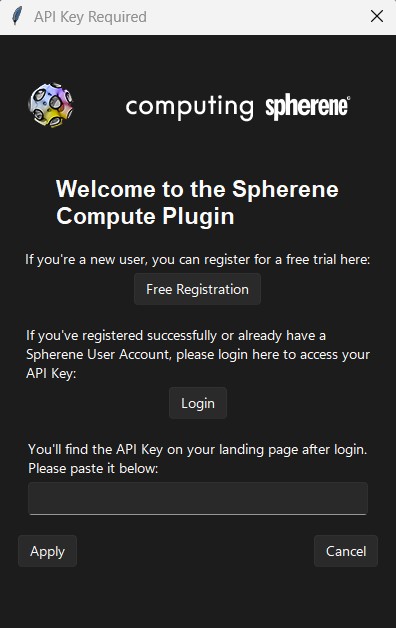
Installation & Uninstallation
- Download the Spherene Add-in installer from the Autodesk App Store.
- Run the installer to install or uninstall the Spherene Add-in.
Overview of Spherene in Fusion
(This documentation reflects updates for the upcoming version of SphereneFusion. Users of previous versions may notice new functions and icons, but the overall workflow remains similar.)
In Fusion, you can find the following tools in the Spherene plugin:
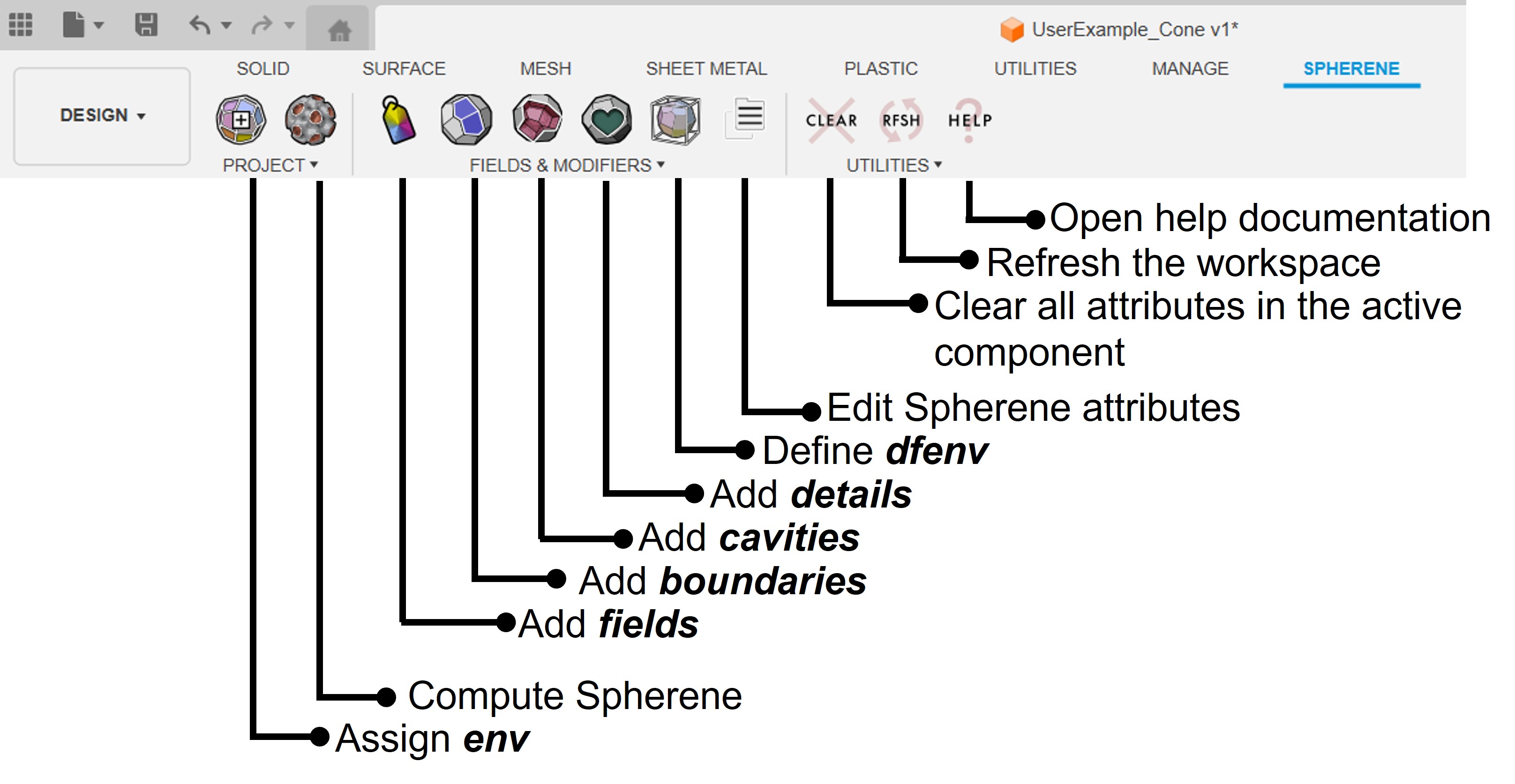
The Project section contains tools to assign the minimal required input to start a Spherene computation—specifically, an envelope env ![]() see details in Envelope & Compute.
see details in Envelope & Compute.
The Fields & Modifiers section includes tools for assigning or modifying Spherene attributes such as fields, dfenv, details, and boundaries, all of which influence the resulting Spherene geometry. If no attributes are specified, default values will be used in the computation. You can find the default values, usage guidance, and examples illustrating the impact of each attribute in the Examples section.
The Utilities section provides three helper tools:
- Clear all Spherene attributes in the active component
- Refresh the workspace to visualize updates
- Open the help documentation in a browser
Envelope & Compute
When you click the Select envelope tool ![]() , a pop-up window will appear prompting you to select an envelope for the Spherene computation:
, a pop-up window will appear prompting you to select an envelope for the Spherene computation:

Here, you can choose to clear all attributes in the active component when selecting a new envelope, ensuring a clean setup for the next computation. This checkbox is especially useful when computing multiple bodies within the same component, allowing you to assign either identical or distinct attributes to each body.
Clicking the compute button ![]() opens the following pop-up window, where you can set the parameters for the Spherene computation:
opens the following pop-up window, where you can set the parameters for the Spherene computation:
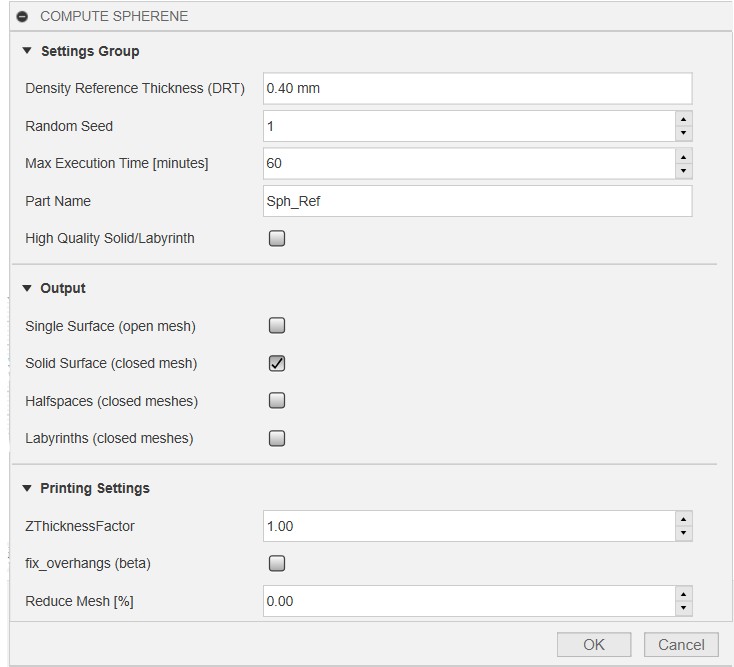
Parameters in Settings Group
Density reference thickness(DRT): Defines the reference wall thickness of the generated Spherene geometry when nothickness fieldis provided—that is, for constant wall thickness. The default unit of DRT is millimeters, and it should be a float value greater than 0.1. Lower DRT values produce more complex geometries with higher genus (i.e., more holes or handles) but also significantly increase computational cost. Halving the DRT can increase computation time by up to 8× and memory usage by up to 6×.
-
Random Seed: Sets the random seed for the computation. It should be an integer between 1 and 9,999. -
Max Execution Time: Specifies the maximum allowed runtime before the computation is automatically terminated. -
Part Name: A user-defined name assigned to the generated Spherene geometry.
High quality solid/labyrinth: when enabled, this option outputs a higher-resolution mesh for the solid or labyrinth geometry.
Parameters in Output
You can specify the type of output you want from Spherene:
Single Surface: Generates a "paper-thin" geometry with no wall thickness.Solid Surface: Generates a solid geometry with wall thickness.Halfspaces: Outputs the actual geometries of the two halfspaces.Labyrinths: Outputs the actual geometries of the two domains (labyrinths).
Parameters in Printing Settings
-
ZThicknessFactor: Scales the Spherene overhangs slightly to produce thicker tops. This helps ensure that FFF slicers generate more solid layers on top surfaces. -
fix_overhangs: Enables or disables the creation of support points where overhangs are detected. Useful for automatic support generation in slicing software. -
Reduce mesh: Reduces the polygon count of the generated mesh, often resulting in faster slicing during additive manufacturing.
After setting all parameters, start the computation by clicking OK. The compute button will change to ![]() , indicating that the process is running. And a computation pop-up window will appear:
, indicating that the process is running. And a computation pop-up window will appear:
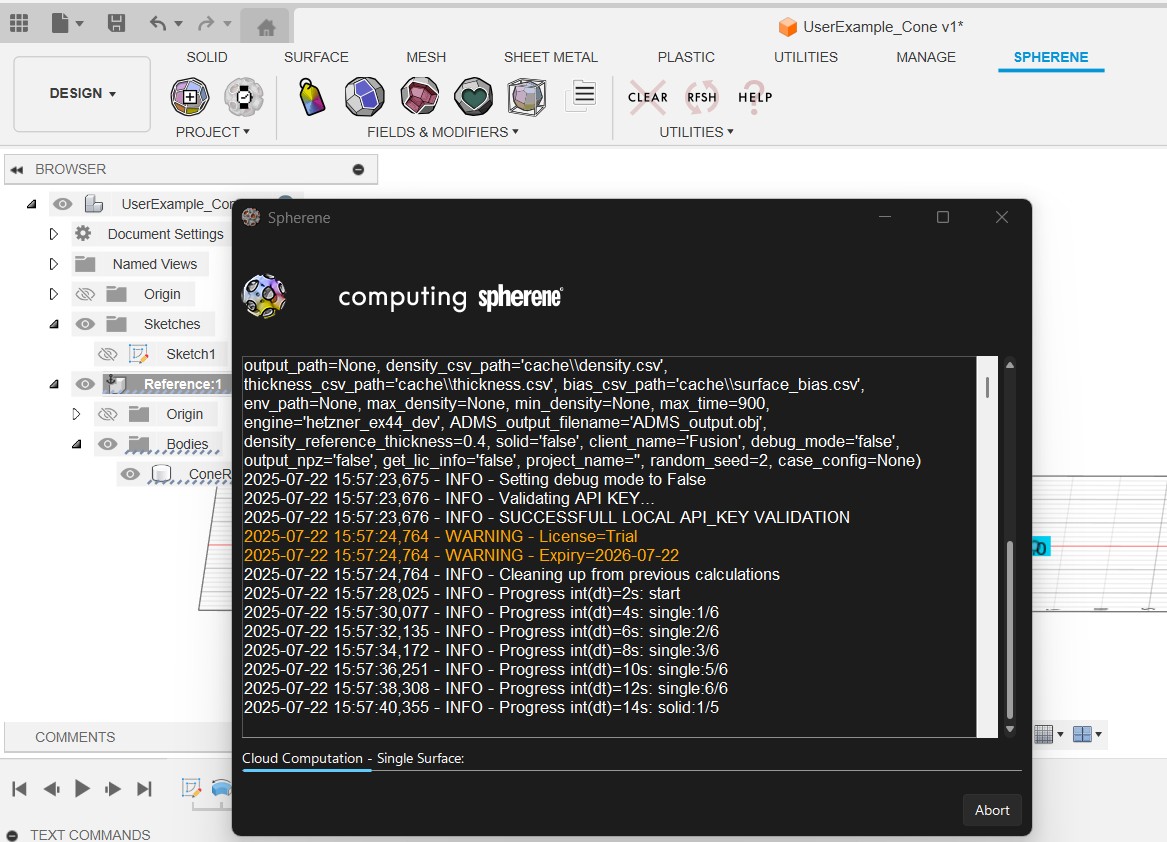
Once the computation successfully completes, the pop-up window will close automatically, and the resulting Spherene geometry will be placed in the same component as the input envelope body:
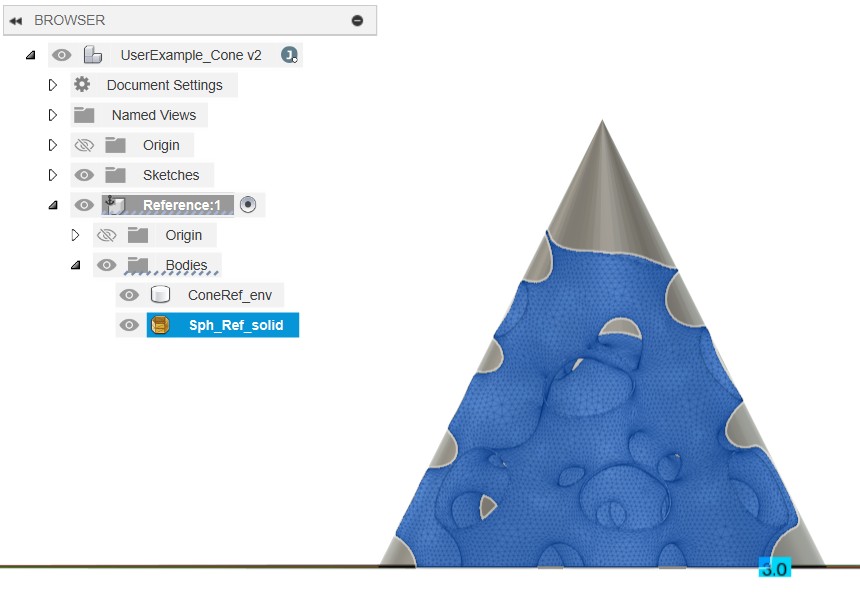
Examples
The Spherene Add-in generates Adaptive Density Minimal Surfaces (ADMS), also known as Spherene geometry, based on a given envelope. By adjusting various attributes, you have the flexibility to tailor the generated Spherene structure to your design needs.
There are five main Spherene attributes you can modify:
 Field
Field Boundary
Boundary Cavity
Cavity Detail
Detail Density field envelope (
Density field envelope (dfenv)
Once any of these attributes are assigned, you can later modify or remove them using the Edit Spherene attributes tool ![]() .
.
In this section, we use a simple example with a cone-shaped envelope to demonstrate how to use these tools and the effect of each attribute. You can download the example file from this link.
Fields
There are three field types that can be introduced for Spherene computation:
Density
Defines the percentage ratio of the generated Spherene volume to the envelope volume: . The default value is 5.6%.
Thickness
Specifies the wall thickness of the generated Spherene geometry (unit: mm). If not explicitly set, it defaults to the value defined in Density reference thickness see Envelope & Compute.
Surface Bias
Determines how the minimal surface shifts from its ideal position (Surface Bias = 0) along its normal direction. A value of -1 shifts it fully in the negative direction; a value of 1 shifts it fully in the positive direction. The default value is 0. The Surface Bias controls variations in surface morphology of the generated Spherene geometry see Constant field.
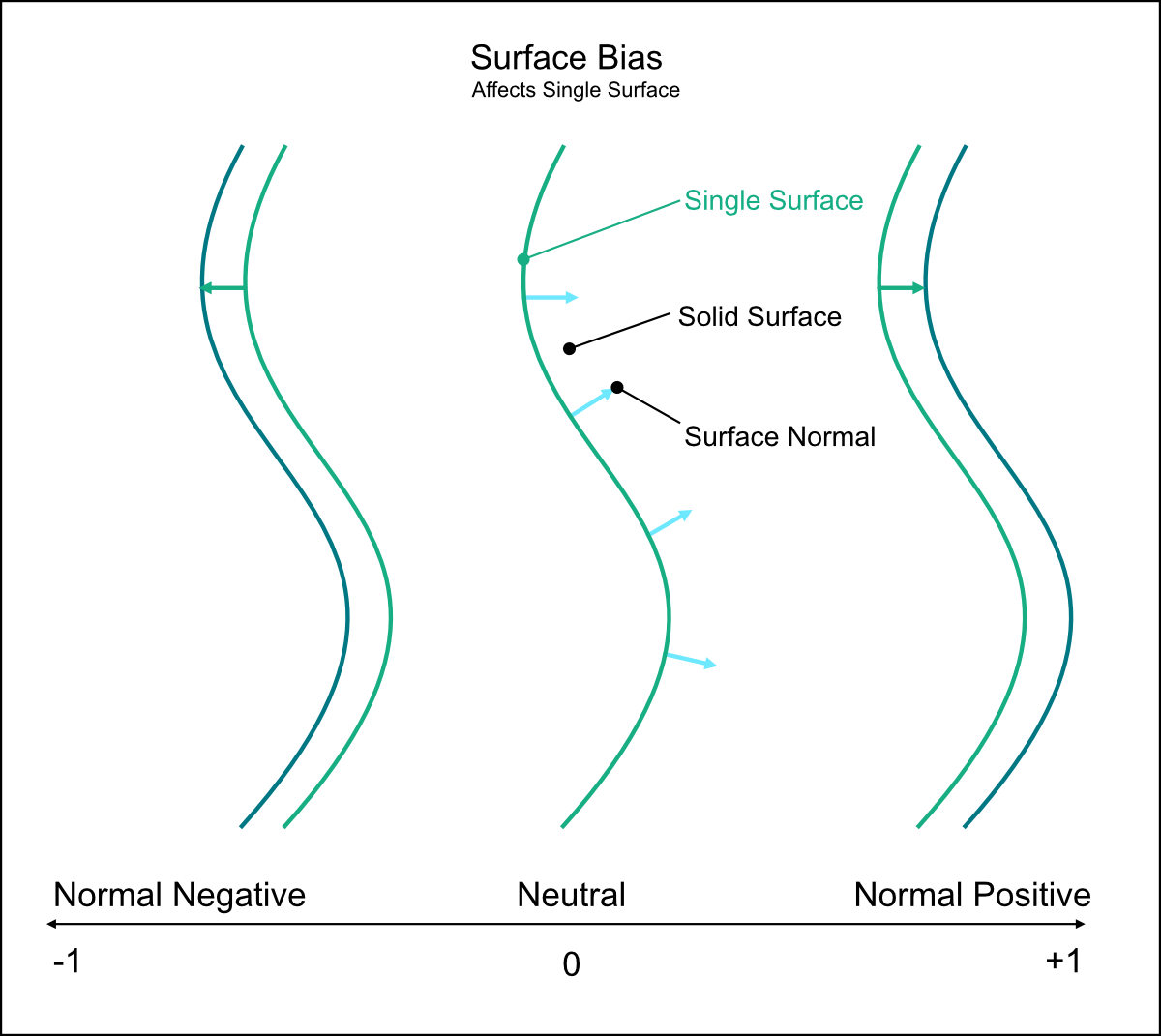
Field Specifications
For each field type:
- If not explicitly set, the default value will be used.
- If only one value is provided, the
fieldis treated as constant across the entire envelope (example see Constant Field. - If multiple values are assigned, a spatial
fielddistribution will be generated over the envelope. For example, assigning twofieldvalues to two distinct points creates a gradient between them. You can even assignfieldvalues to various geometries to produce more complex field distributions, enabling more advanced and customized designs (example see Field Grading.
Constant Field
As an example, we assign a single field value Surface Bias=1 to the cone envelope by clicking the Add/Edit Field button ![]() . In the pop-up window, we choose the desired
. In the pop-up window, we choose the desired field type, enter the desired value, and select the point/surface/body to assign the given field value:
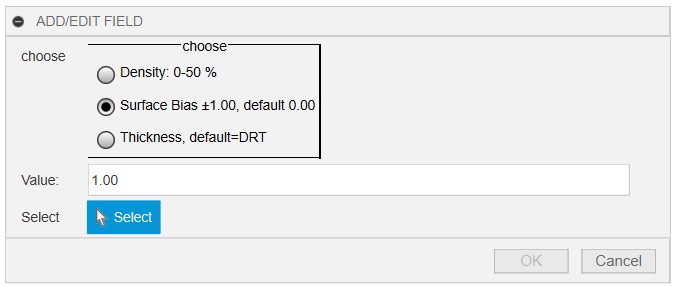
After clicking OK, this will create a constant field with the given value. And you will see a label representing the assigned field. The background color of the label represents the field type: Density (blue), Thickness (pink), and Surface bias (yellow):
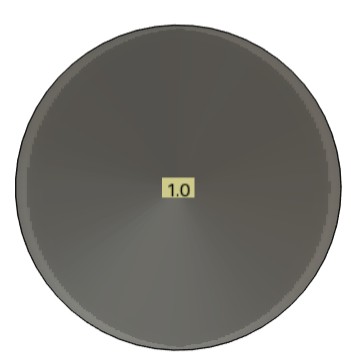
If the field labels do not appear, follow these steps:
- Go to the top-right corner of Fusion and navigate to
Preferences > Design > Assemblies. - Uncheck Active Component Visibility and click
OK. - Then click the
Refreshbutton to update the view. The labels should now be visible.
to update the view. The labels should now be visible.
After assigning field values for the first time, you can edit them at any point by clicking the Edit Spherene Attributes tool ![]() . The following figure shows Spherene geometries generated with various constant
. The following figure shows Spherene geometries generated with various constant Surface Bias:
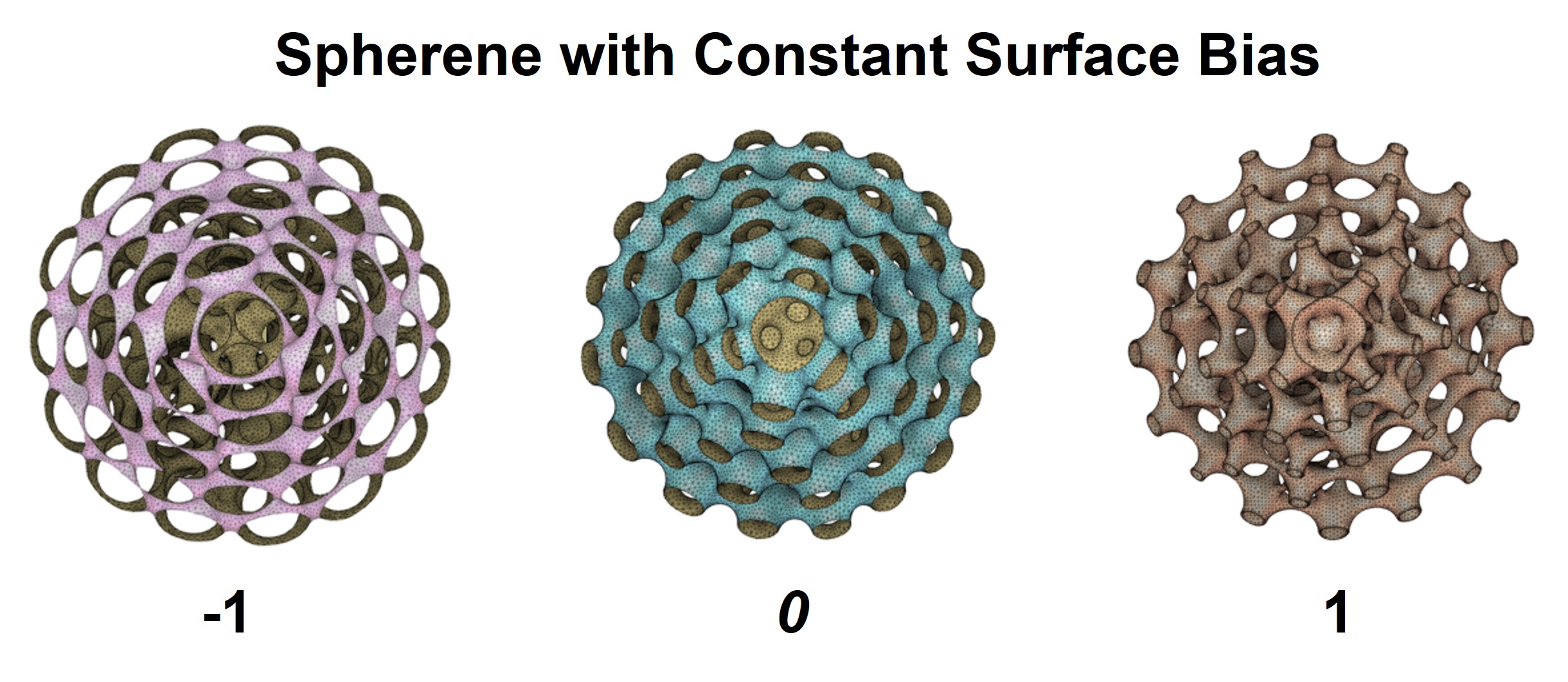
Field Grading
When assigning different field values to multiple vertices, surfaces, or bodies, a spatial distribution "grading" of the field will be generated based on the specified values. In this example, we create two curved surfaces and assign different Thickness values to each using the Add/Edit Field tool ![]() :
:
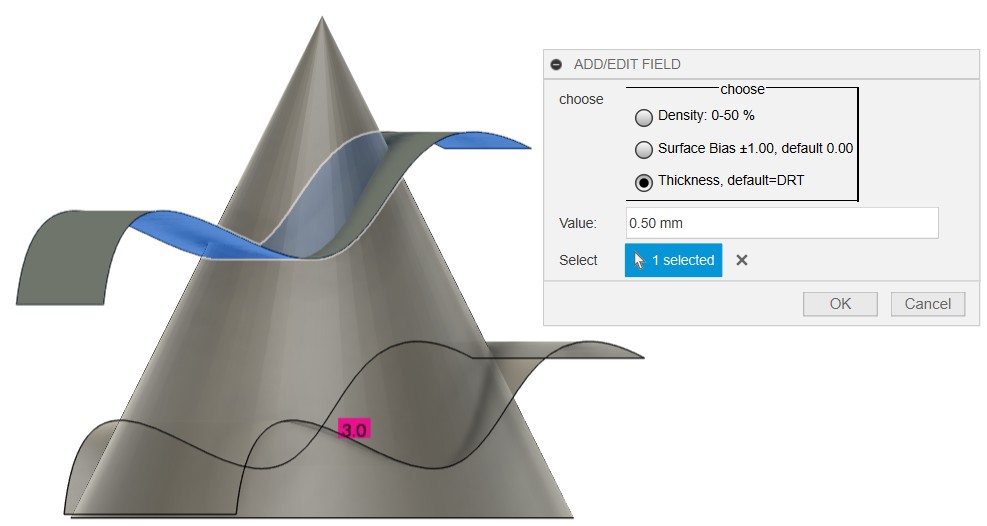
The resulting Spherene geometry will exhibit a spatially varying thickness.
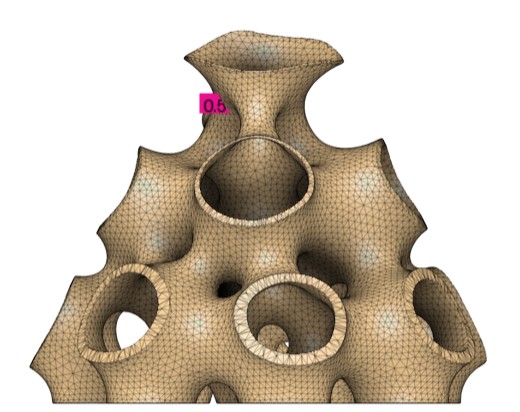
If you want to use a mesh as the envelope, you must first convert it to a solid to apply fields with more than one point.
If the mesh contains more than 10,000 triangles, it is recommended to:
- Create a simplified solid with fewer than 10,000 triangles, or
- Create a temporary solid specifically for assigning the field.
Boundaries
The Boundary tool ![]() allows you to modify the boundaries of the generated Spherene structure.
allows you to modify the boundaries of the generated Spherene structure.
In this example, the cone surface is divided into four parts, each defined as a separate boundary with different settings. After clicking the Boundary button ![]() , select the desired surface and configure the boundary settings in the pop-up window.
, select the desired surface and configure the boundary settings in the pop-up window.
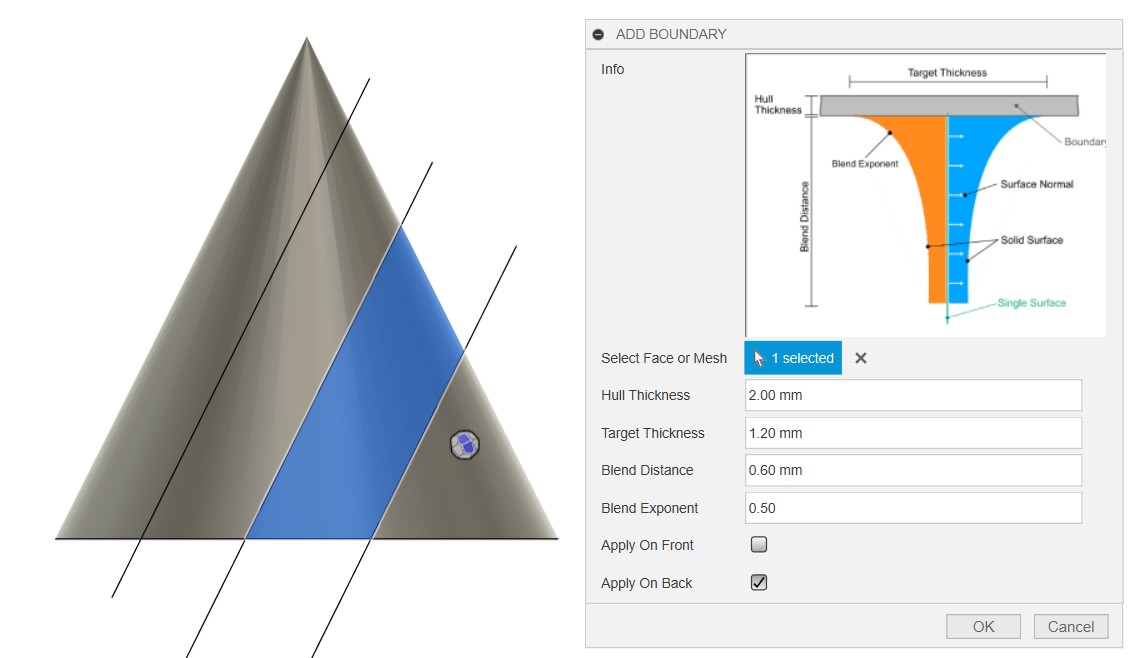
The figure within the pop-up window illustrates how the boundary is generated and explains the corresponding parameters. The general logic behind boundary generation is to grow the Spherene structure near the boundary into the boundary surface with a given parameter set, including Hull thickness, Target thickness, Blend distance, and Blend exponent. These parameters control how the geometry blends into the defined boundary region.
The options Apply on front and Apply on back in the Boundary setting provide additional control over the surface morphology of the generated Spherene structure. The figure below illustrates the effects of enabling each option.
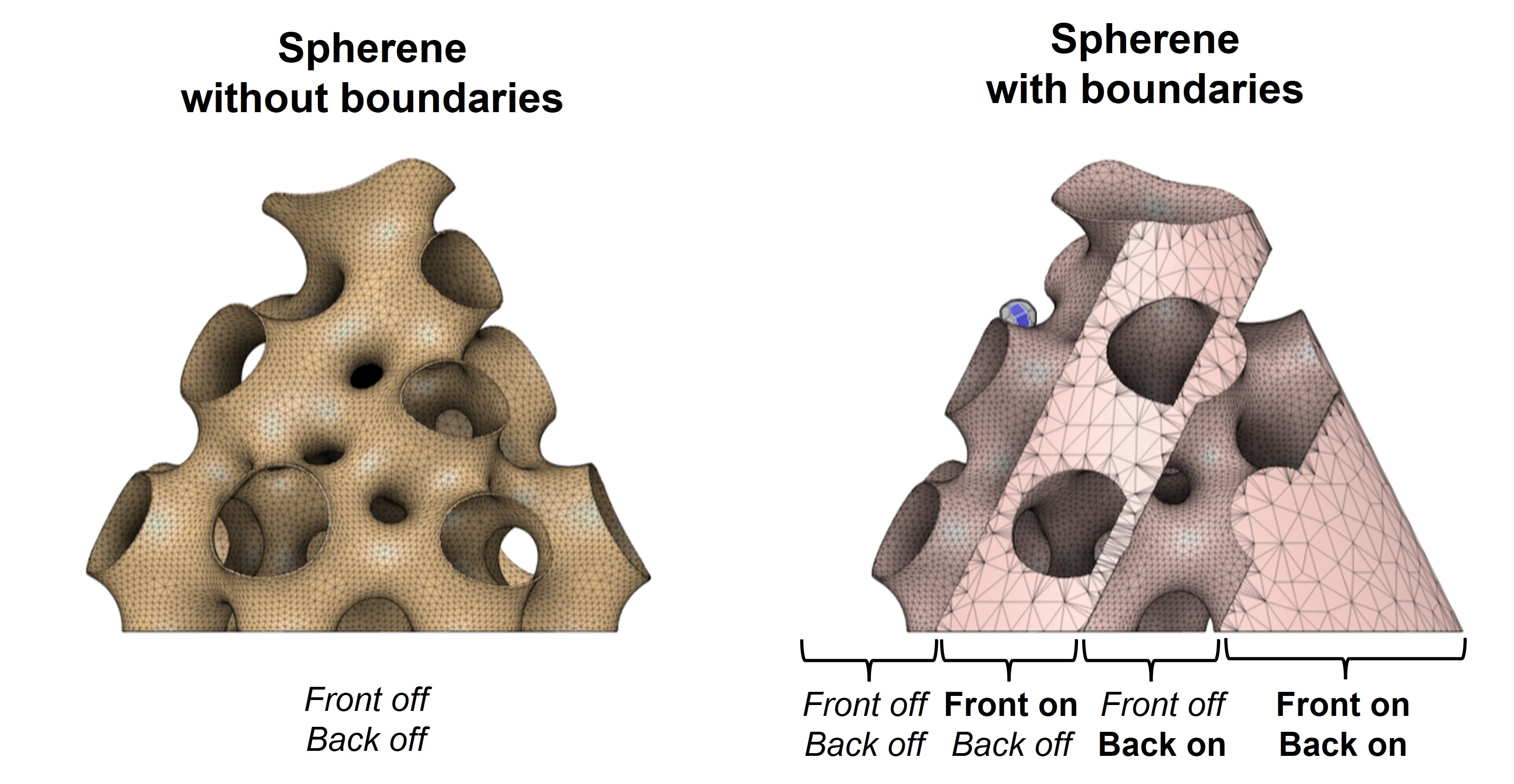
From the figure above, you can observe the following behavior:
- When
Apply on backis ON, the volcano holes on the boundary are filled. When OFF, they remain open. - When
Apply on frontis ON, the area surrounding the volcano holes on the boundary is filled. When OFF, it remains open.
Cavities
Using the Cavity tool ![]() , you can introduce a cavity into the Spherene geometry, which is particularly useful for integrating inlets, outlets, or other functional features.
, you can introduce a cavity into the Spherene geometry, which is particularly useful for integrating inlets, outlets, or other functional features.
In the following example, we introduce a cylindrical cavity on the front side of the cone envelope.
After clicking the Cavity button ![]() , a pop-up window will appear, allowing you to choose whether to apply the cavity in the Back Labyrinth or Front Labyrinth, and to select a Surface or Body to define the cavity.
, a pop-up window will appear, allowing you to choose whether to apply the cavity in the Back Labyrinth or Front Labyrinth, and to select a Surface or Body to define the cavity.
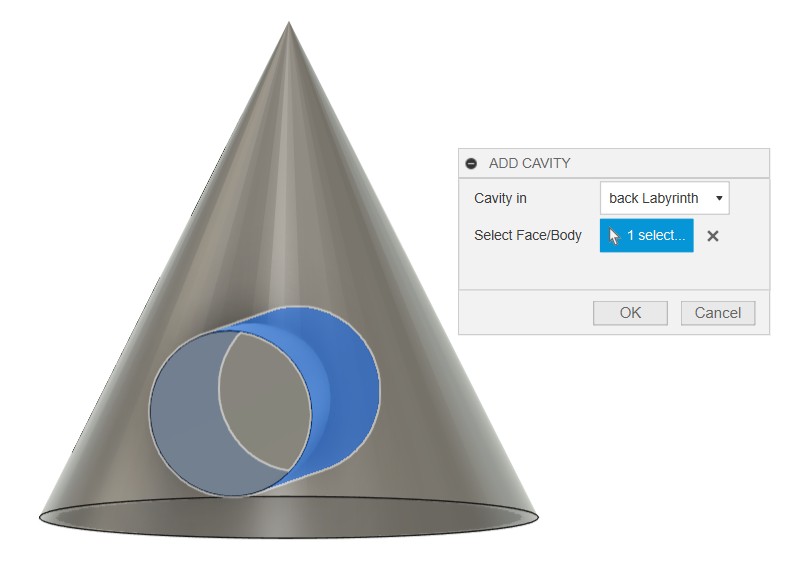
By selecting either Back labyrinth or Front labyrinth, the cavity surface will be landed on different spaces of the ADMS structure. Additionally, the type of cavity geometry you select influences the result:
- If an open Surface is selected, only the area near the surface will be voided.
- If a closed Body is selected, the entire volume occupied by the body will be removed.
The following figure compares three cases: a Spherene geometry with Body Cavity Front, Body Cavity Back, and Surface Cavity Back.
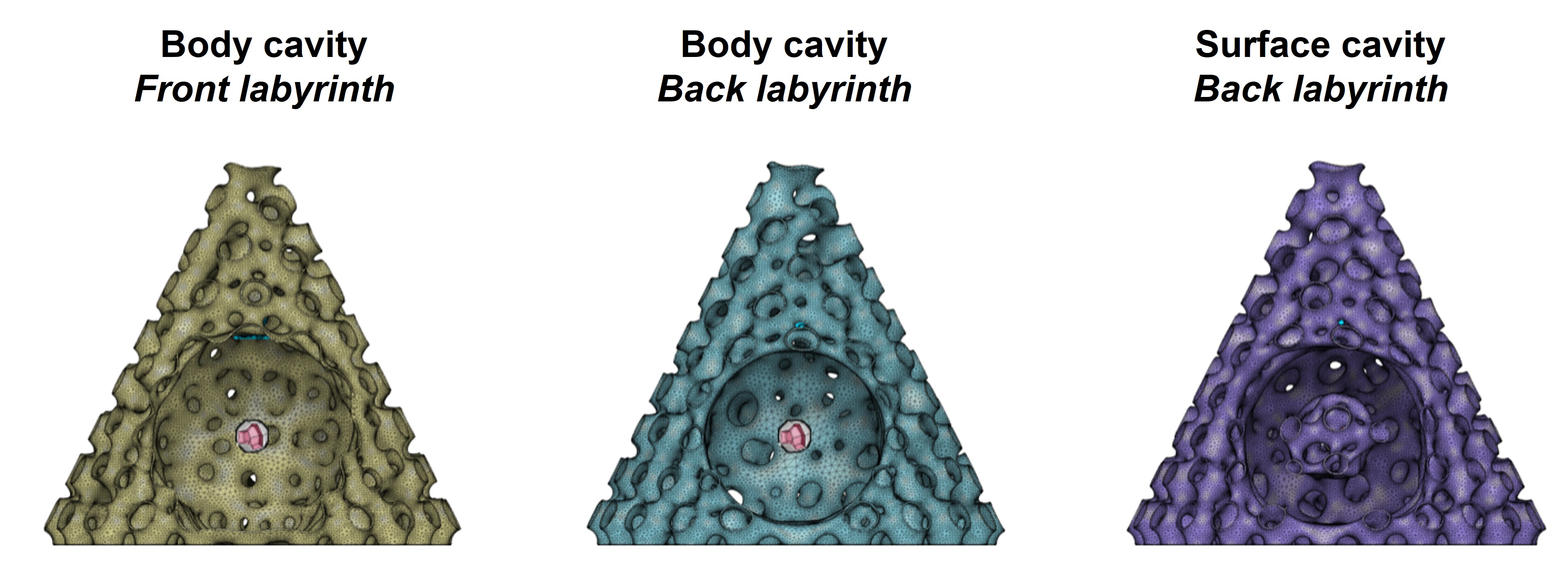
Details
Using the Detail tool ![]() , you can define a closed body as a Detail to either add to or subtract it from the Spherene geometry.
, you can define a closed body as a Detail to either add to or subtract it from the Spherene geometry.
In this example, we add a cylindrical detail to the bottom of the cone envelope and subtract a text body from the cylinder, as illustrated in the figure below:
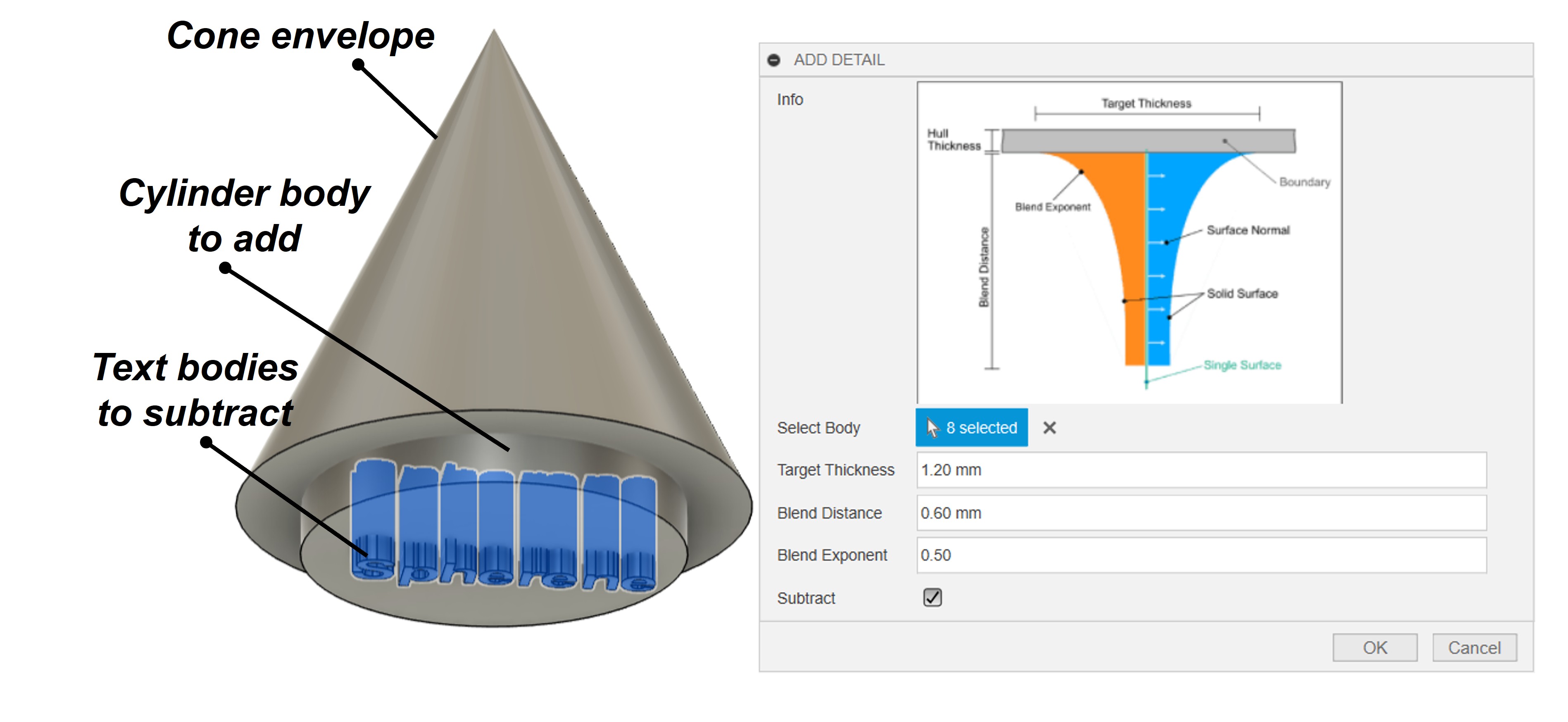
In the pop-up window of the Detail tool ![]() , you can select a body as a detail and choose whether to add or
, you can select a body as a detail and choose whether to add or subtract it from the Spherene geometry. You can also adjust the growth parameters—such as Target thickness, Blend distance, and Blend exponent—to control how the Spherene geometry blends with the added or subtracted Details.
The following figure shows the resulting Spherene geometry with the applied Details:
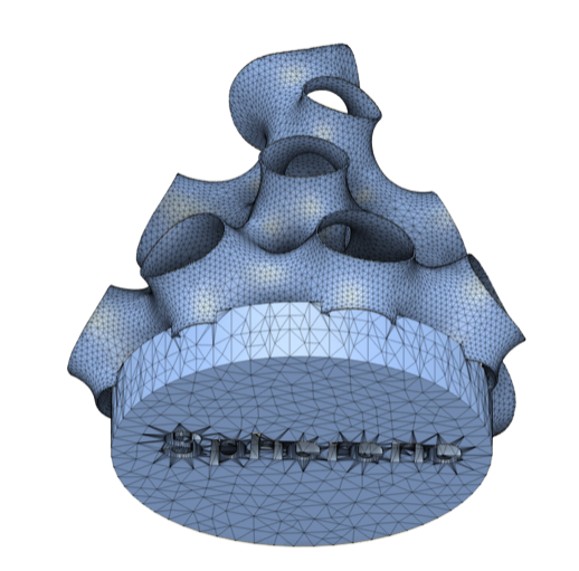
The text body should protrude slightly from the surface of the subtracting body (in this case, the bottom surface of the cylinder). If it does not, the computation may fail due to boolean errors, as text bodies often contain complex mesh geometry.
DFENV (Density Field Envelope)
The dfenv attribute ![]() allows you to input a body as the density field envelope. The default
allows you to input a body as the density field envelope. The default dfenv is set to be the same as the computed envelope env. However, when a dfenv is defined, the Spherene geometry is first generated using dfenv as the envelope, then Boolean trimmed by the original envelope env to produce the final geometry. This enables the generation of Spherene structures at sharp edges or in thin regions where material might otherwise be insufficient,
or it can be used to intentionally avoid generating Spherene geometry in specific areas.
In the following example, we aim to generate Spherene structures at the sharp tip and edges of a cone. To achieve this, we click on the dfenv button and select a box as dfenv (outlined by the black frame) that is larger than the original cone envelope env (outlined by the blue frame).
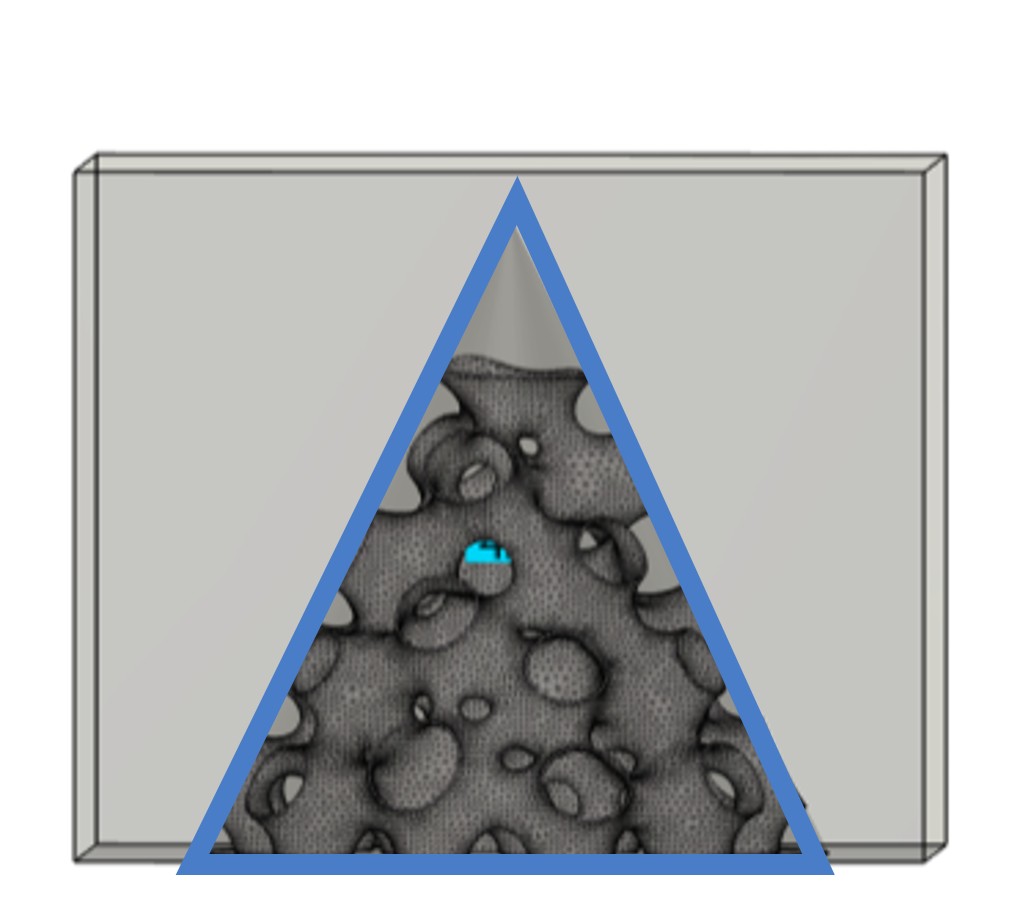
After compute ![]() , the Spherene structure is successfully generated even at the sharp edges and the top tip:
, the Spherene structure is successfully generated even at the sharp edges and the top tip:
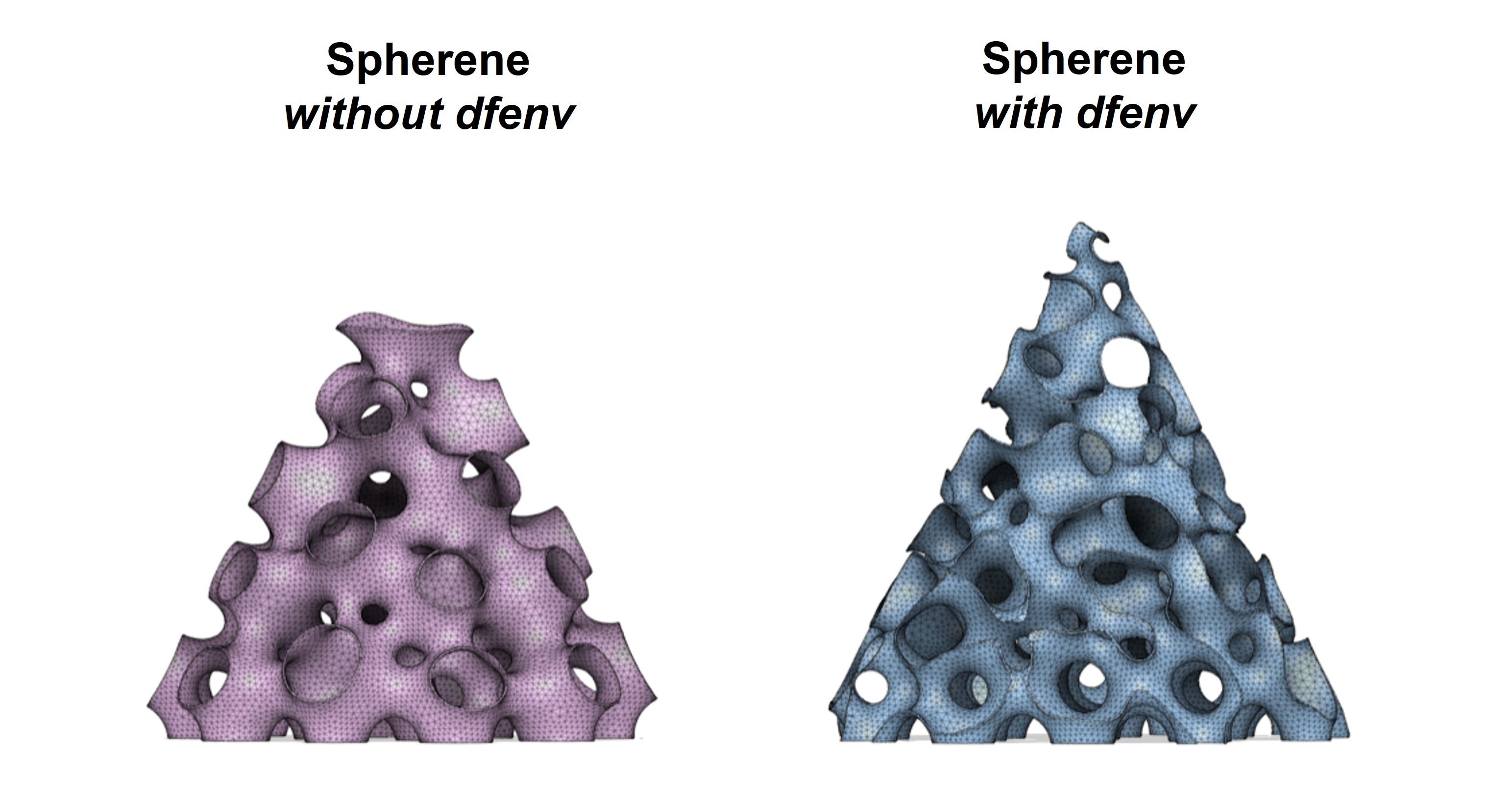
In rare cases, computations may fail due to mesh Boolean issues (e.g., when dfenv is involved), even though our Boolean algorithm is among the most robust available. These issues can typically be resolved by adjusting the density value or slightly moving or enlarging the dfenv. If the problem persists, we encourage you to contact us directly, and we will assist you with your specific case.